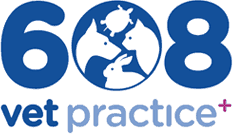Weight control and Obesity in Dogs
Dogs, like people are getting more and more overweight.
Obesity is defined as being at least 20% overweight, but we mustn’t ignore our pets if they are heading that way either. Recent studies found that almost 30% of dogs in the UK are overweight; we as vets would probably put that figure much higher!
Overweight dogs, whether or not they are defined as obese, often experience a reduced quality of life as they are less able to enjoy playing and are at a higher risk of developing or compounding more health problems. We can readily spot the obese dog belonging to someone else but very few of us can accept that our own dog is even slightly overweight!
How do I know if my dog is overweight?
Feel your dog’s ribs with the palm of your hands. You should be able to feel the ribs without having to prod.
When looking at your dog from above, if you look at the outline from head to tail, you should see a dip inwards after the rib cage and before the pelvis. This is your dog’s waist.
When looking at your dog from the side, if you look at the outline from head to toe, you should see the belly tuck slightly upwards after the ribs and before the hind legs. They should have a waist.
If you can’t see or feel these things, unfortunately your dog is overweight.
You may also want to weigh your dog and compare their weight with recognised breed tables.
Registered clients can weigh their dogs in the Main Solihull surgery any time between 9am to 7pm from Monday to Friday, or 9am to 12.30pm on a Saturday, on our walk-on scales. We have set them just to the edge of the waiting room area for your use.
At our branches, we ask that you telephone and arrange a time with the nurse for weighing.
What are the effects of obesity?
Joints:
One of the most common detrimental effects is on the joints. More weight means more wear and tear, which means more arthritis. One study looked at paired Labrador puppies from the same litters, tracking them until they passed away naturally, many years on. One of each pair was fed a ‘normal’ amount; the other of the pair was fed 75% and remained slim. At the end of their lives, their hips were compared, and they found a profound difference between each.
So whether your pet is young or old – look after their weight, to look after their joints!
Heart and breathing:
More weight means more work. This is particularly important in breeds that are prone to heart or breathing problems. For example, Cavaliers unfortunately almost always develop heart murmurs. If they are overweight, then problems tend to be made worse by excess weight. Also Yorkies can develop a ‘collapsing’ trachea or windpipe. Being overweight makes coping with this much more difficult. So keep them slim, so they can cope much better!
Anaesthetic Risks: Simply put- the more overweight, the higher the anaesthetic risk. Some operations can be delayed to allow for weight loss, but many cannot.
Sugar Diabetes:
As with people, obesity can promote diabetes starting up. Being overweight also means a diabetic is more resistant to any insulin that is present. Diabetic dogs usually then require treatment for the rest of their lives.
What causes obesity?
Like us – too much to eat for what they truly need, and not enough exercise to burn off the calories causes obesity.
There are a variety of factors that make it difficult for us as owners to know what to feed our pets, and so control their weight.
Guidelines on most shop-bought packaging often are way above what is needed, so you may need to ignore them.
Neutering can reduce a pet’s requirement by up to 30%. That’s a BIG change!
Portion sizes: Consider how much smaller your pet is to you. If you have a medium-sized terrier and you’re an average-sized woman, you are probably about 8-10 times the weight of your dog. So if you give your dog a little treat of a dog biscuit, it’s like you eating 8-10! Apart from them not tasting too nice, that is quite a substantial treat…
Not enough exercise to counter the food eaten: Not all overweight dogs can exercise, especially the ‘old timers’ and those with painful joints. Not all of us have much time to take our dogs out, we have busy lives. But do what you can, as exercise is good for all our health in so many ways, however young or old.
What can you do for your pet?
Keep them slim from the start:
If you have a puppy or a dog that is not overweight – monitor their weight and their body score lifelong. Anticipate when feeding changes may be needed. For example, after neutering, if they need to rest up after an injury or operation, if you can’t take them for so many walks, middle age and when they are old. Keeping ahead of the game is the key. Life stage diets are a real aid – they are designed for young active growing pups, to neutered or non- neutered adulthood, through to old age. Not only do they help with weight control, but with teeth, joints, immunity, reducing work for organs as they get older, and so on…
Meals and snacks:
Feed as often as you like, BUT make sure that the total in the day is balanced and the right amount. You may find it easiest to set out what is to be fed at the beginning of the day, so there are no extras, or no accidents with 2 people in the family give your dog their tea.
If granny likes to feed your dog all day long – give her a bowl of the right amount to dry kibble for the day.
If the kids (or husband) keep feeding extras- make up a titbit bowl- maybe some chopped up carrots and part of the biscuit or kibble allowance for the day. Train them (the family) to take from there.
Instead of biscuits – may be chopped up veg. Or instead of two biscuits, give two halves.
You don’t have to give up the joy of treating your pet, or change your routine; you just need to plan what you’re feeding overall.
Use a light or lower calorie diet;
There are many on the market now. Most large manufacturers do them.
Hills Vet essentials for adults is light and has added health benefits. If you are a Pet Health for Life plan member, you will also benefit from a 10% discount.
Exercise:
This helps burn off the calories, keeps your dog strong, healthy and amused, and can be great fun. Walks in the park, using a toy with some of their kibble inside, playing in the garden are all good forms of exercise.
Older arthritic dogs may just manage a potter around the house or garden, or walk past a couple of lampposts and back. Not much energy used up, but those stiff joints have been loosened up, their muscles have been used and they know the ‘social scene’ from their sniffing around.
NOTE: Young, large breed puppies should not have too much exercise until their skeleton is mature enough. This can be up to 18 months of age. Ask your vet for advice as this varies from breed to breed.
What we can do for you?
Nurse Weight Clinics:
Once a dog becomes overweight, it is a big challenge to lose weight safely and then maintain the ideal weight. Attending one of our weight clinics will allow you to have your dog measured and weighed. Then you can discuss your dog’s diet and exercise regime with one of our trained nurses, setting realistic goals. Regular checks with the nurse will help you keep up momentum and examine new regimes if one doesn’t work. Remember, every gram lost is one less to lose! Rapid weight loss is to be avoided; a slow steady weight loss programme is encouraged.
These clinics are free of charge for our registered clients. Just make an appointment.
We have an excellent range of reduced calorie ‘light’ diets, lower calorie ‘prescription’ diets, which the nurses can advise you on. Pet Health for Life plan members qualify for discounts on the life stage diets.
When combined with extra exercise if your pet can do it, the weight loss should be steady and affective. Exercise provides a good interaction between owner and dog and there’s a whole host of toys we can provide to encourage a lazy dog to play!
Tests for other Underlying illnesses:
For some dogs there is an underlying problem, such as hypothyroidism (underactive thyroid) and Cushings Syndrome. In which case tests will be needed for a diagnosis.




